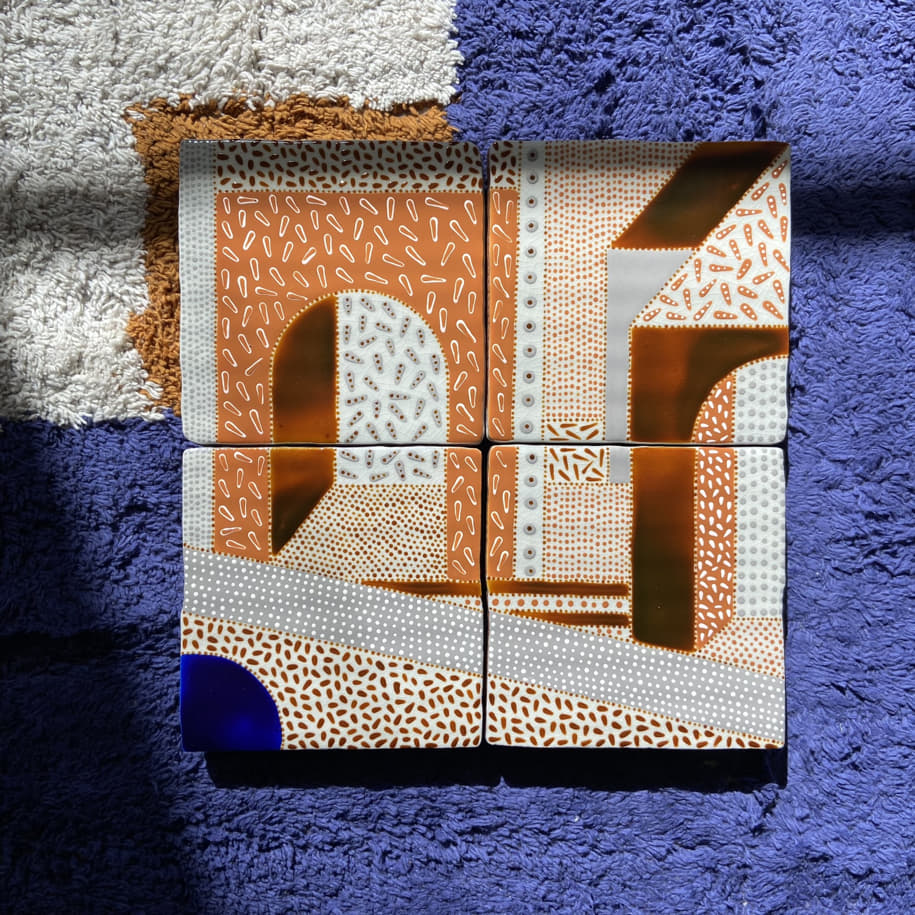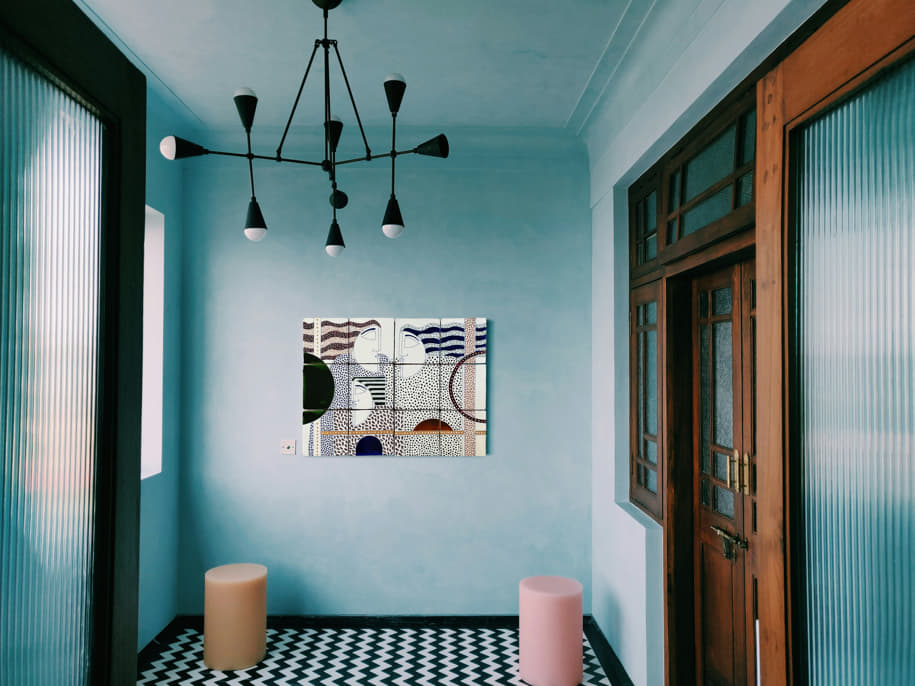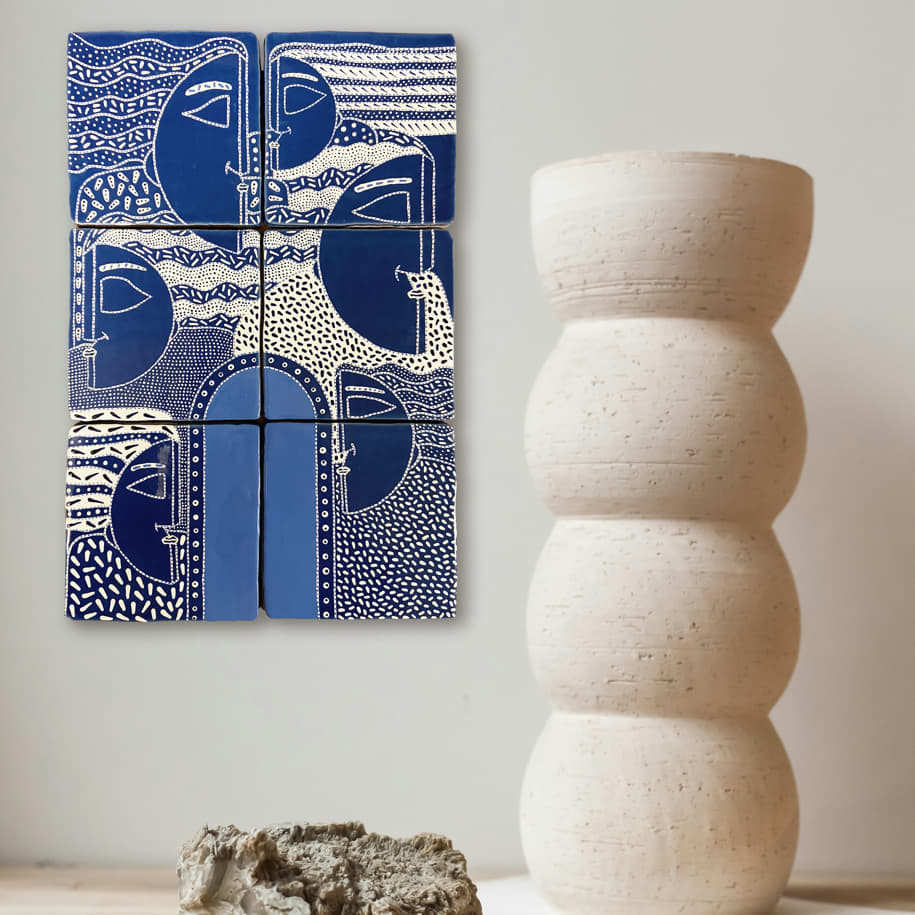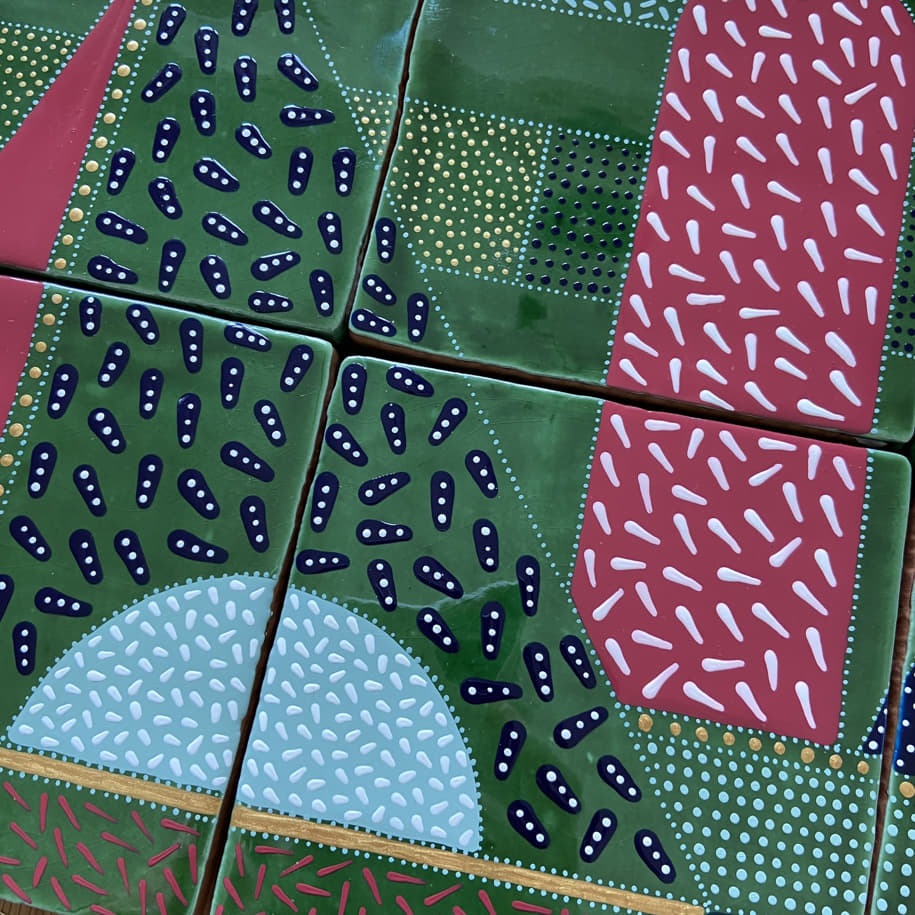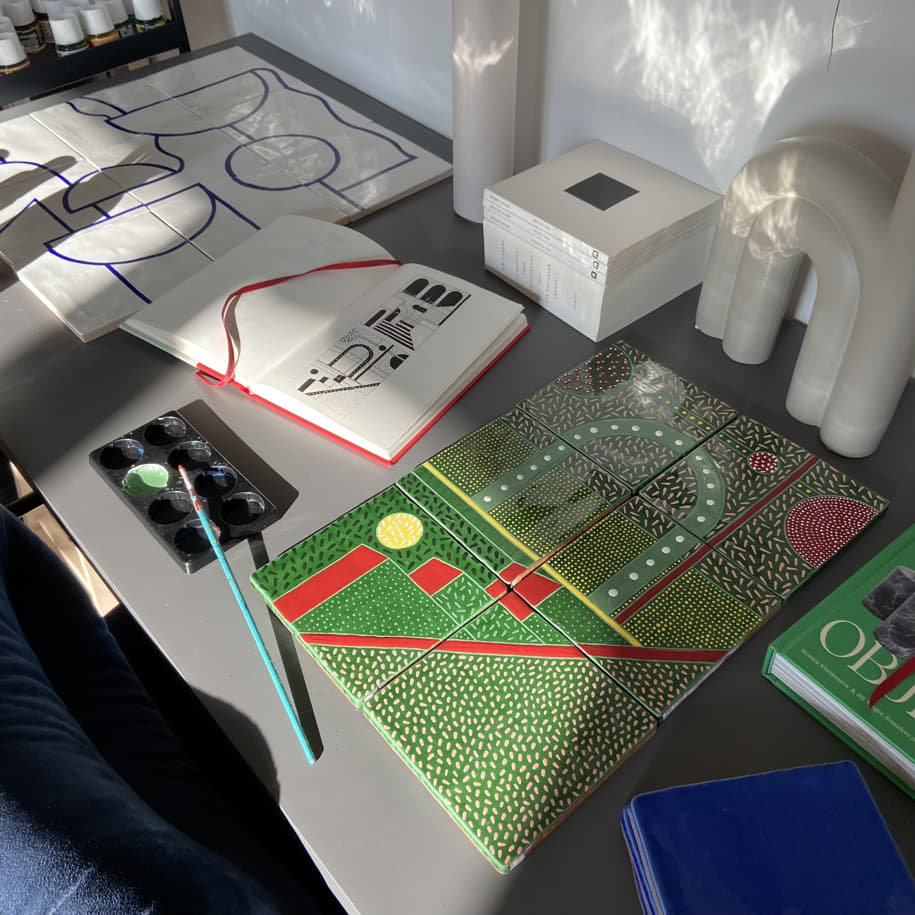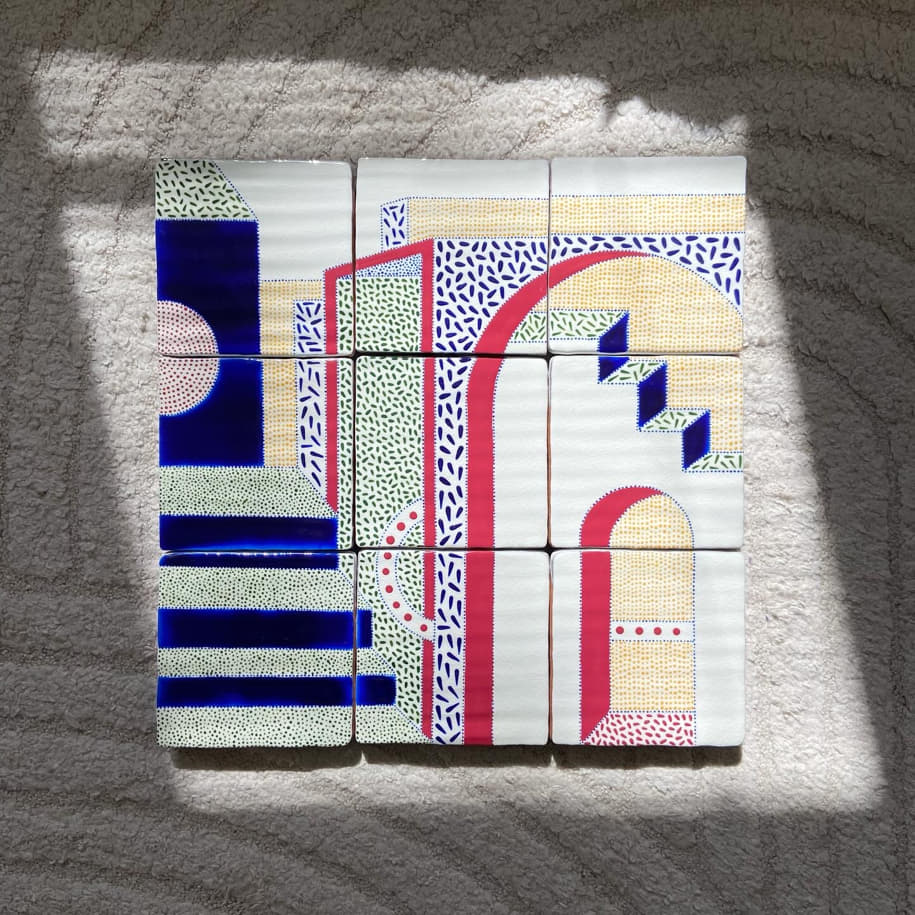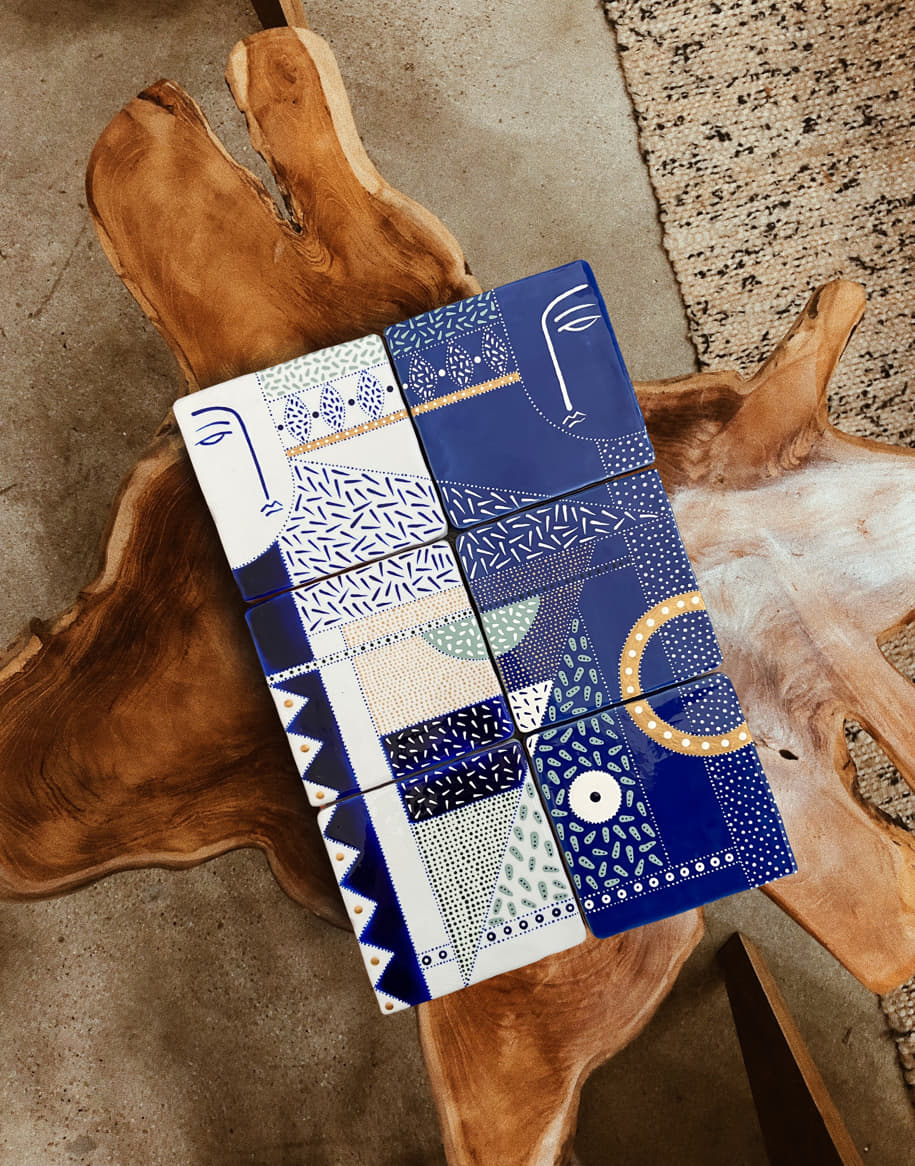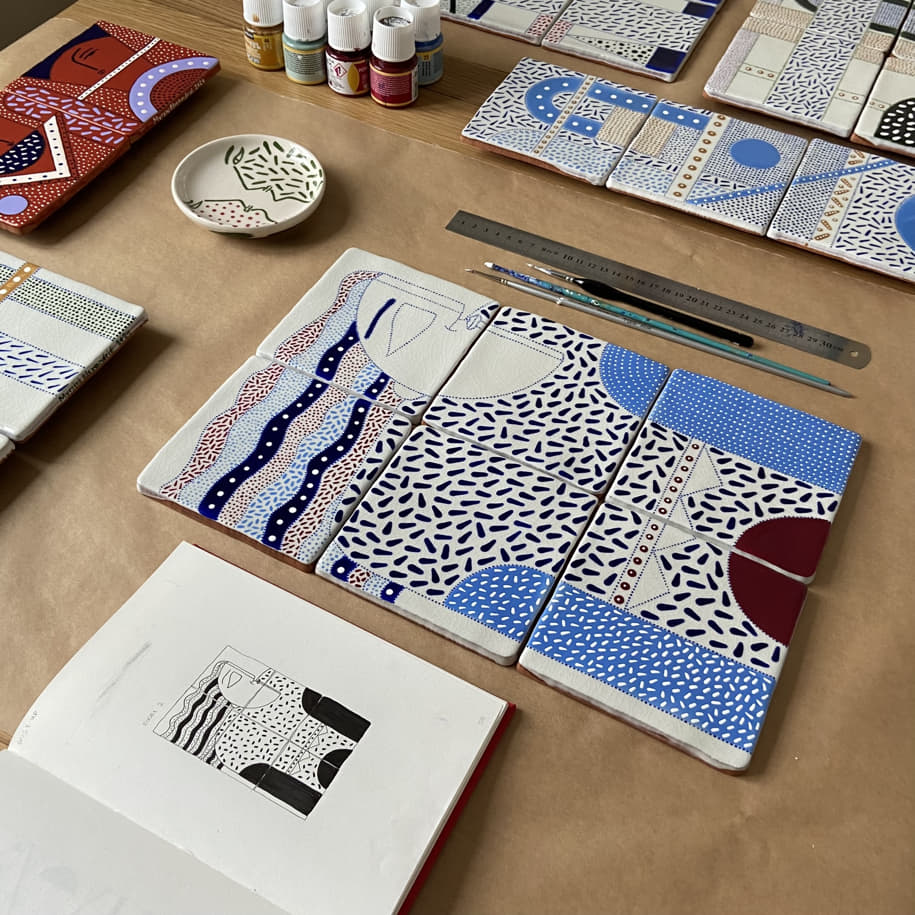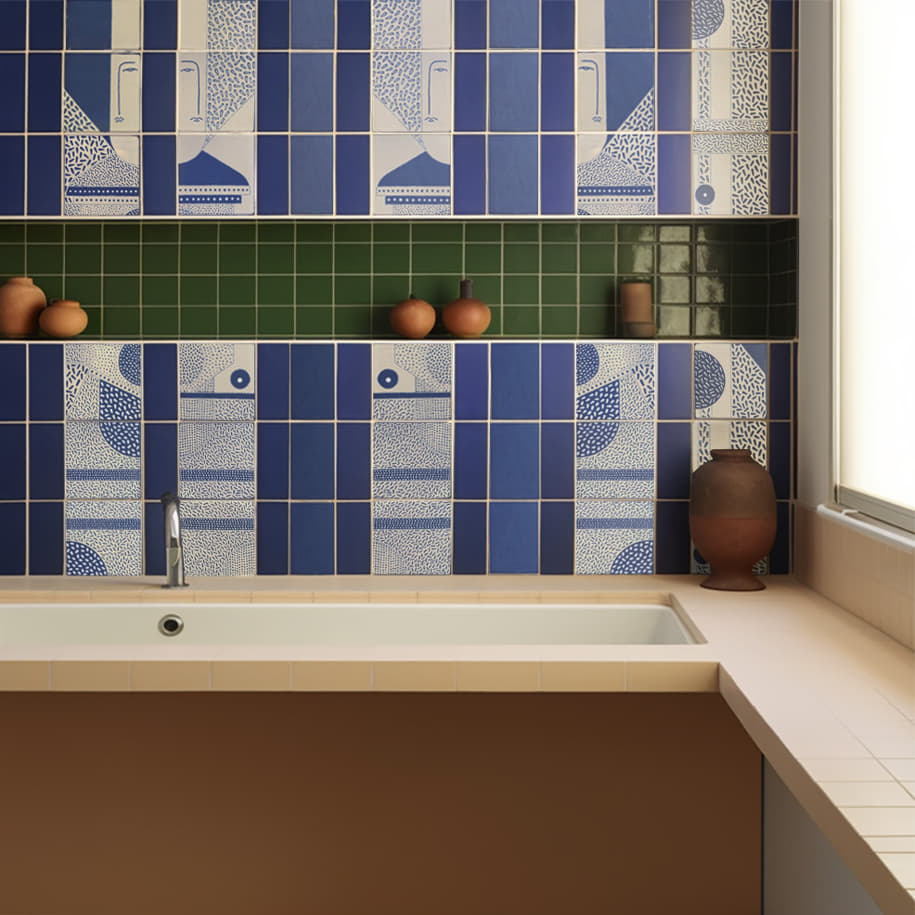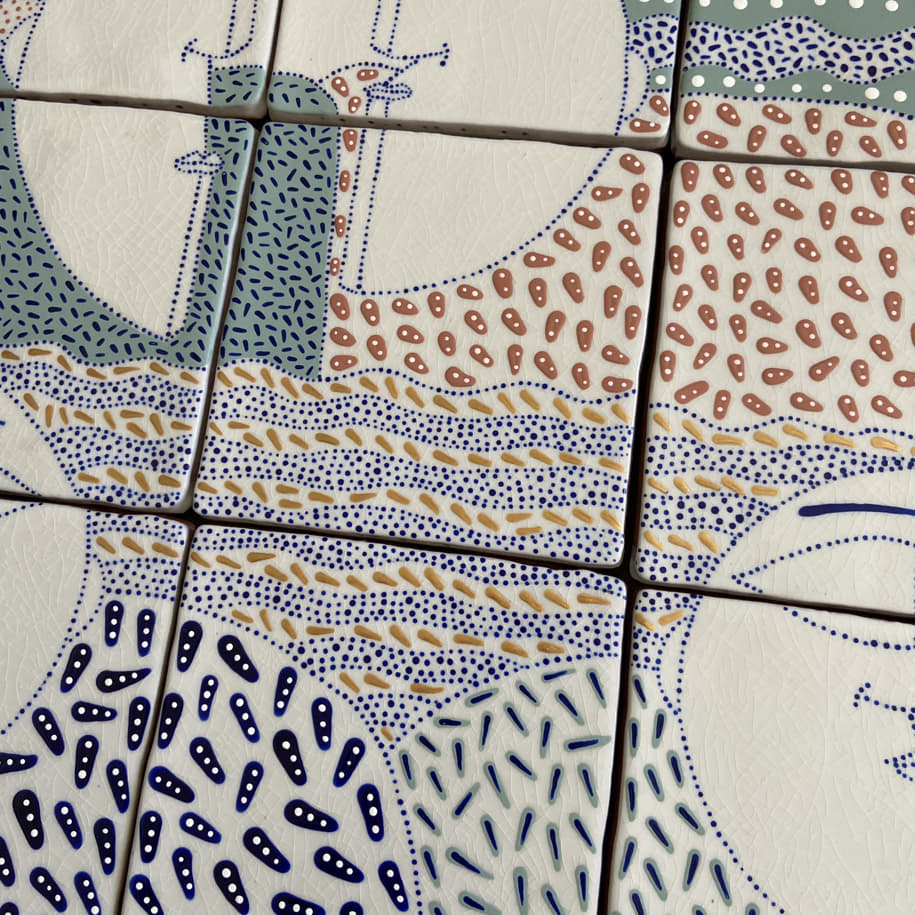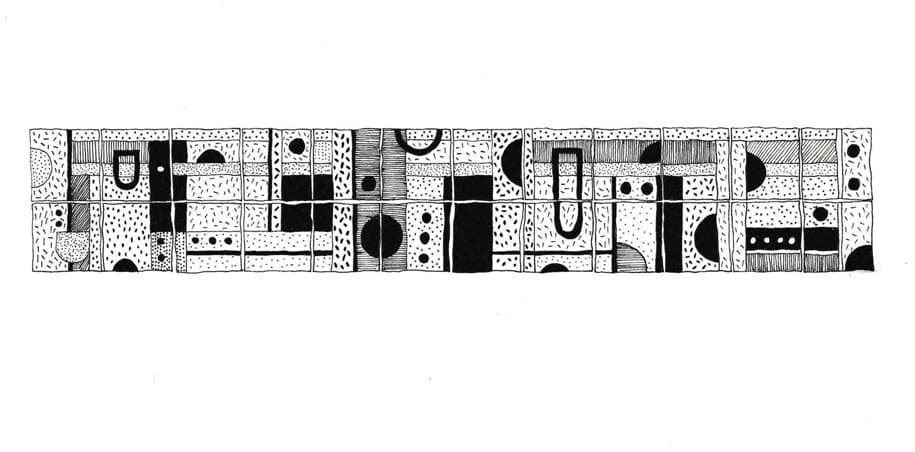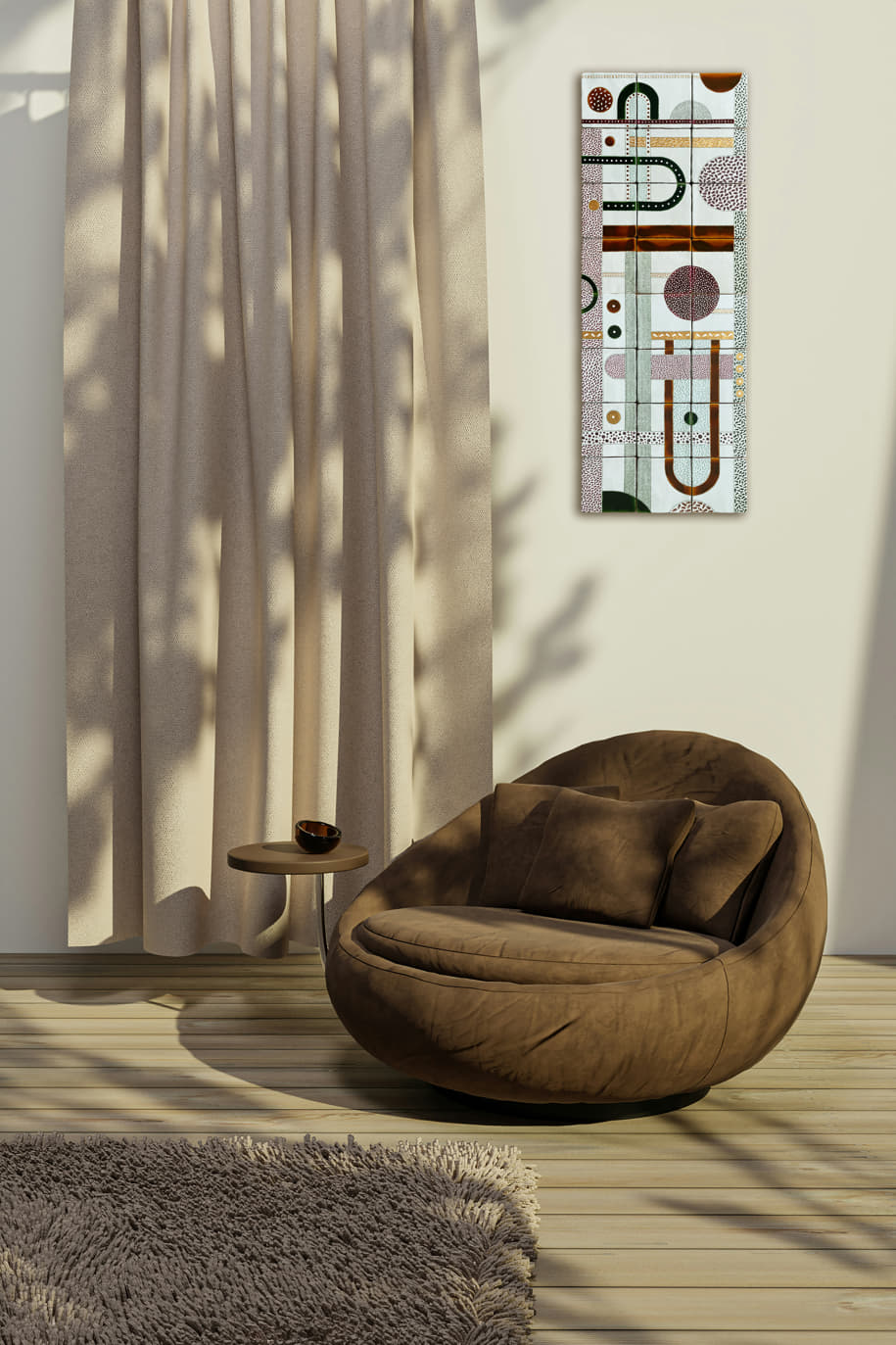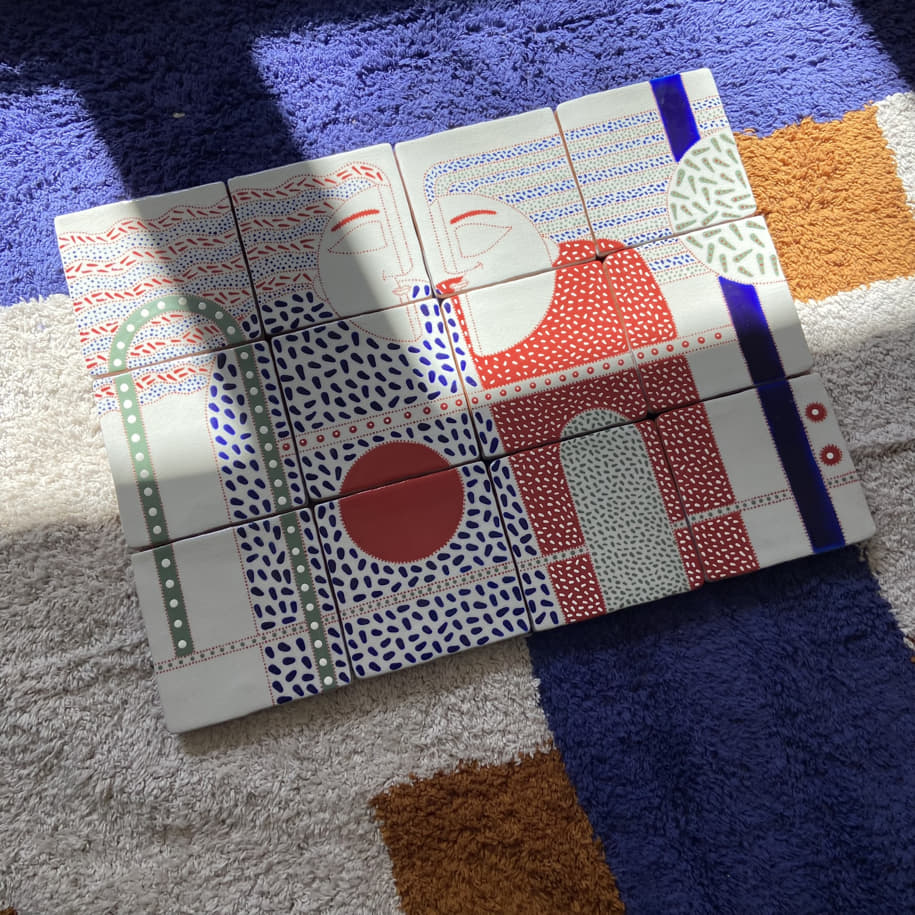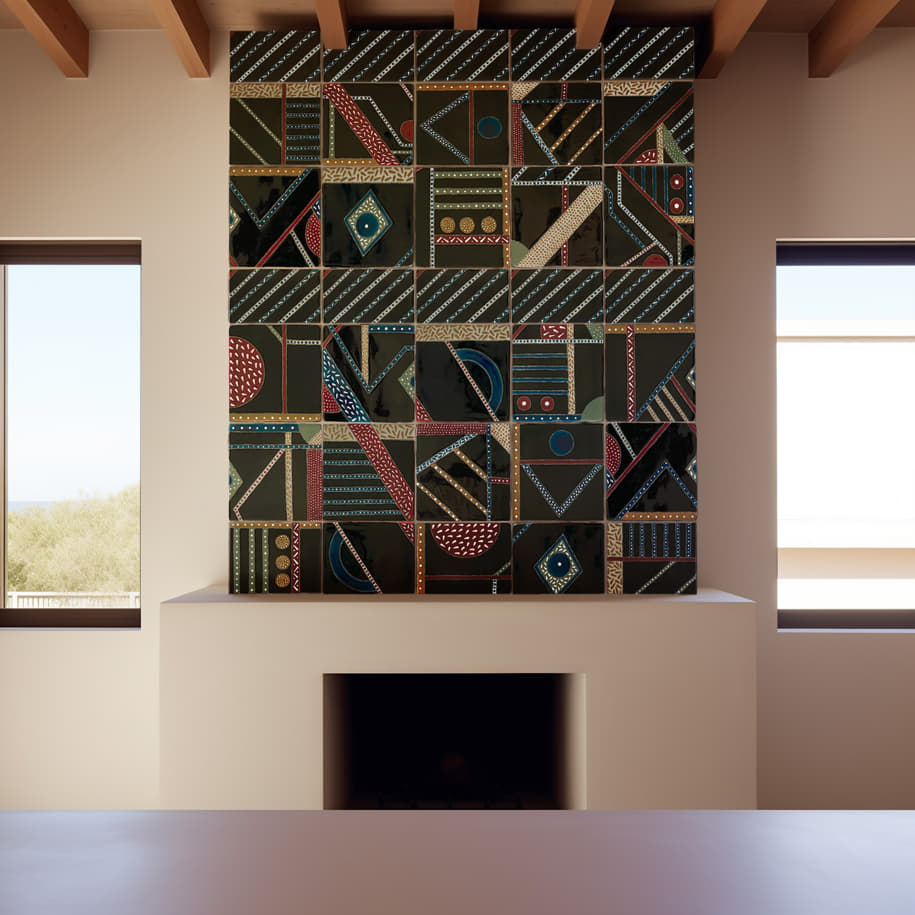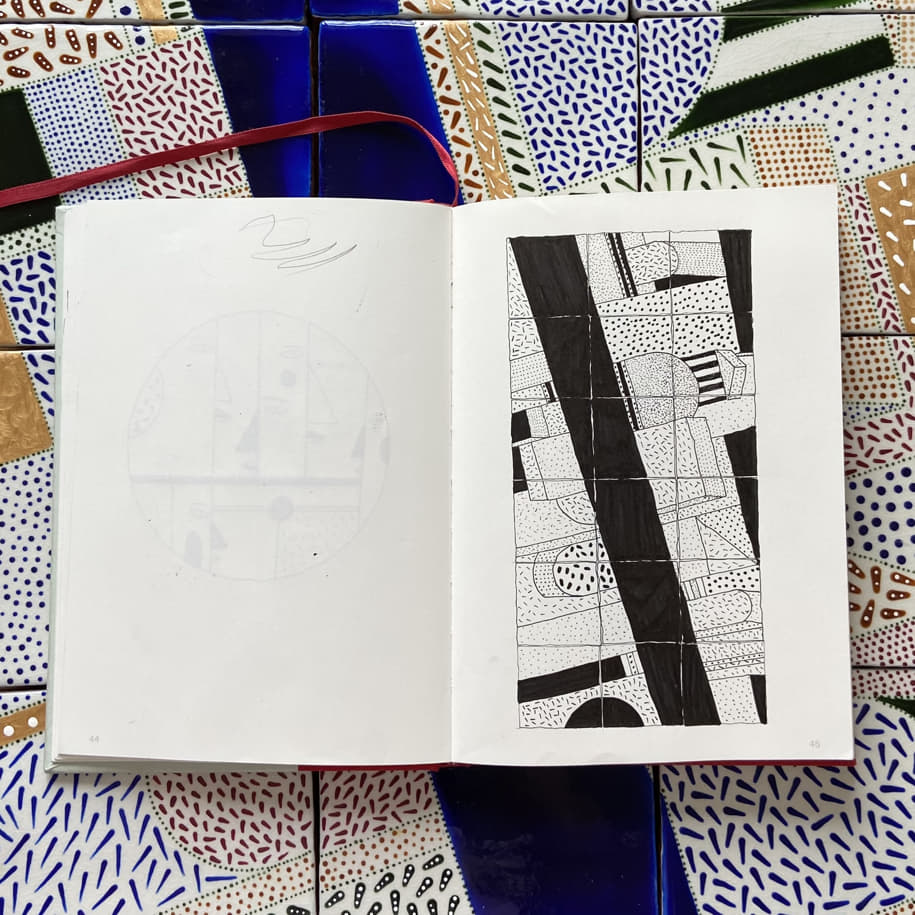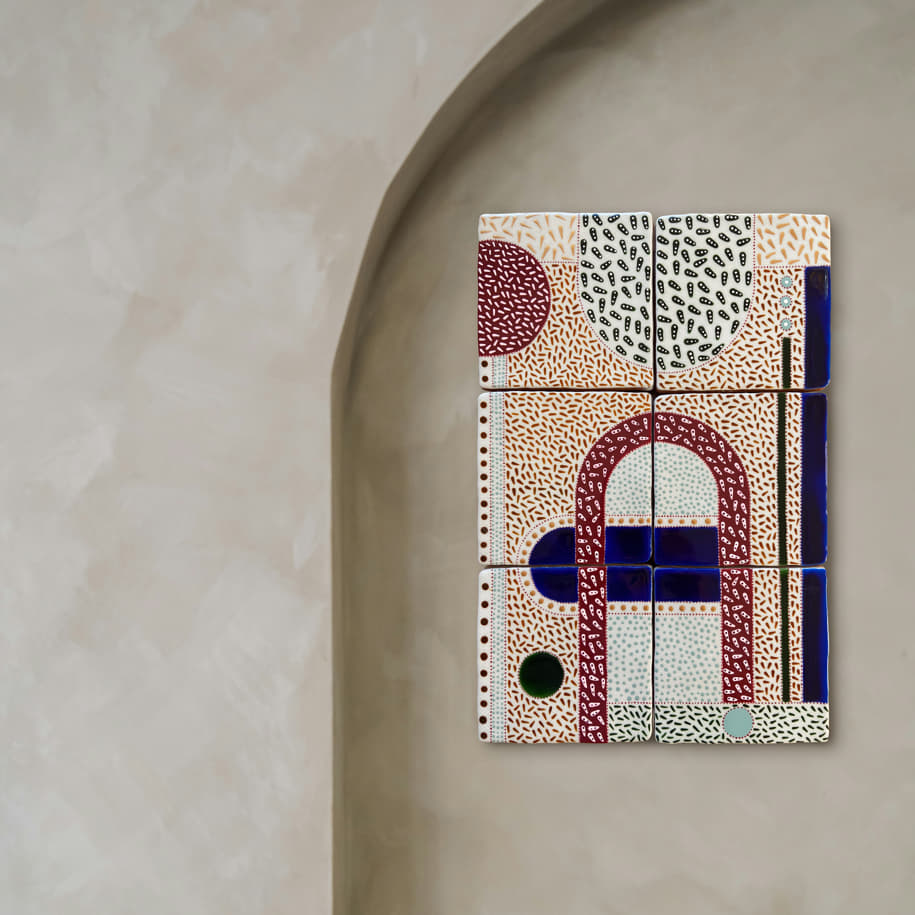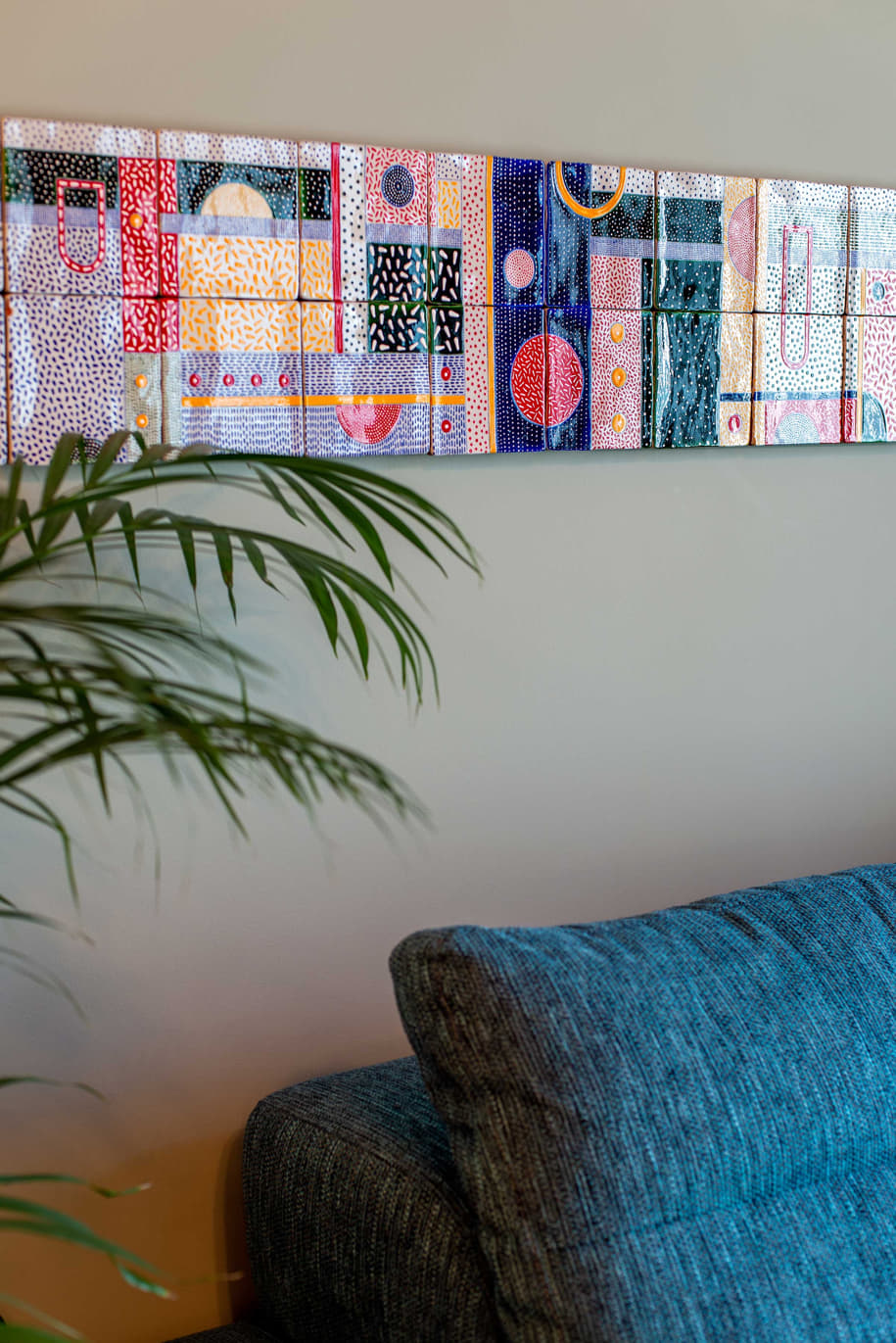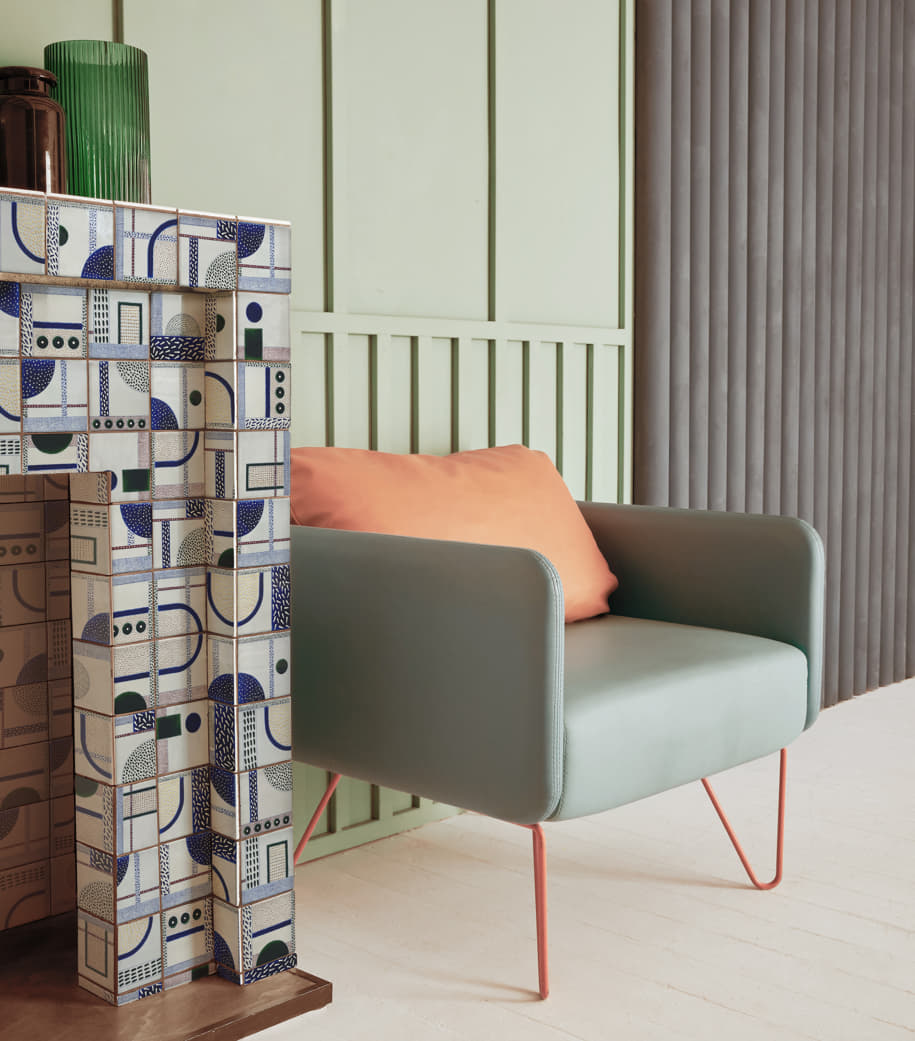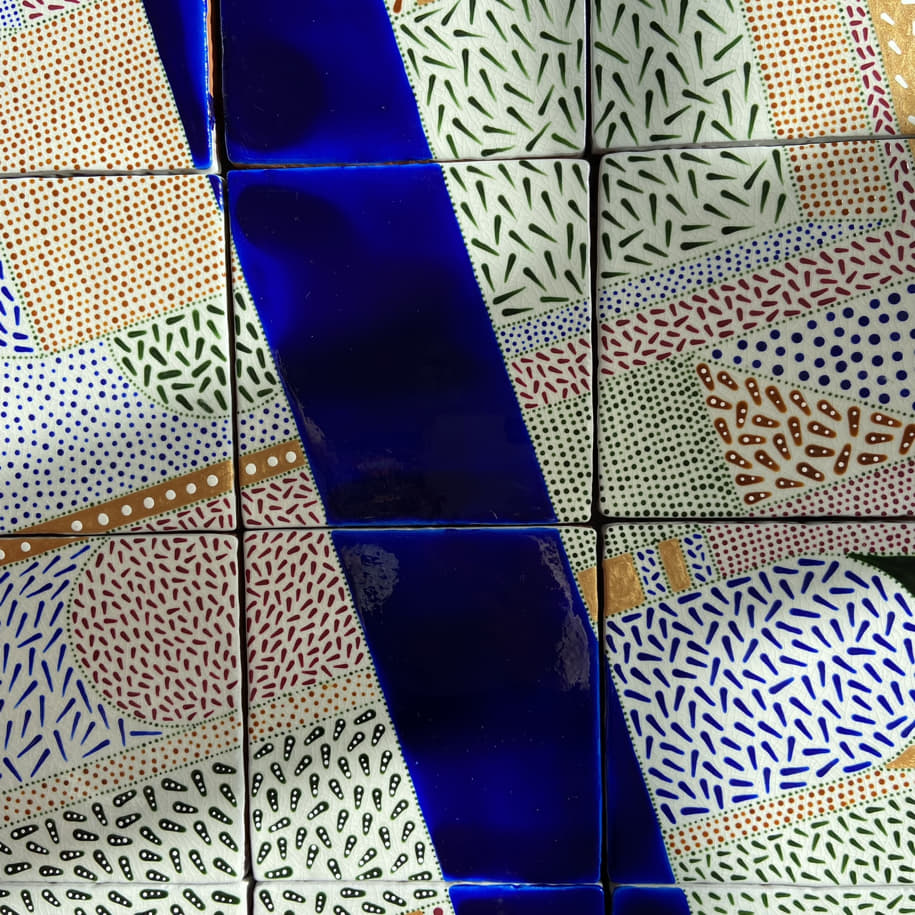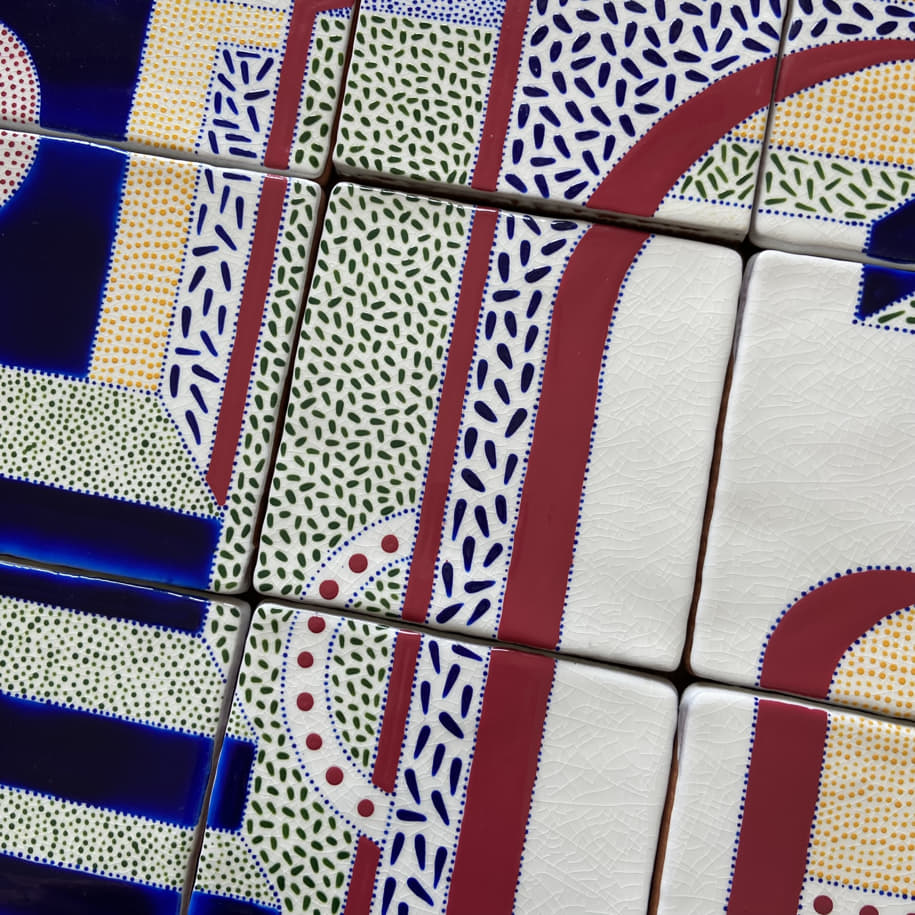Η Μυρσίνη Αλεξανδρίδη, αρχιτεκτόνισσα και καλλιτέχνιδα, συζητά με την συντακτική ομάδα του Archisearch.gr, για την επαγγελματική της πορεία, τις καλλιτεχνικές και εννοιολογικές αναφορές του έργου της και την χειροτεχνική διαδικασία. Παρακολουθώντας την σκέψη των Ελλήνων καλλιτεχνών και συγγραφέων της γενιάς του ’30 και αντλώντας έμπνευση από στοιχεία της ελληνικής παράδοσης και ιστορίας, η τέχνη της Μυρσίνης Αλεξανδρίδη αναζητά μια “σύγχρονη ελληνικότητα”.
Πώς ήρθε στη ζωή σας η αρχιτεκτονική και το σχέδιο;
Σπούδασα αρχιτεκτονική στο ΕΜΠ. Πριν από την εισαγωγή μου στη σχολή, δεν είχα καμία άμεση επαφή με την αρχιτεκτονική, πέρα από το γεγονός ότι με γοήτευε η πολυπλοκότητα της πόλης και η ευελιξία και απλότητα των μικρότερων κοινοτήτων, όπως τα νησιά.
Θεωρούσα την αρχιτεκτονική ως μια κινητήρια δύναμη για τη δημιουργία αναμνήσεων, σχέσεων και μνημών. Αυτή η αντίληψη, σε συνδυασμό με την αγάπη μου για τη ζωγραφική και το σχέδιο, που είχα από μικρή ηλικία, συνέβαλαν στο να ακολουθήσω το μονοπάτι της αρχιτεκτονικής. Τελικά, αυτή η πορεία με οδήγησε και στην ενασχόλησή μου με την τέχνη.
Ζείτε και δραστηριοποιήστε στην Στοκχόλμη. Πώς προέκυψε αυτή η μετακίνηση και πώς έχει επηρεάσει την καλλιτεχνική και επαγγελματική σας εξέλιξη;
Μετακόμισα στη Στοκχόλμη πριν από περίπου έξι χρόνια, αμέσως μετά την ολοκλήρωση των μεταπτυχιακών μου σπουδών στο Berlage στην Ολλανδία. Είχα φίλους αρχιτέκτονες που εργάζονταν ήδη στη Στοκχόλμη και με έπεισαν ότι το σκανδιναβικό μοντέλο εργασίας θα μου ταίριαζε.
Από τότε εργάζομαι ως αρχιτέκτονας και στις αρχές του 2020 ίδρυσα την καλλιτεχνική μου επιχείρηση. Πλέον, ασχολούμαι αποκλειστικά με την τέχνη, έχοντας αποχωρήσει από το αρχιτεκτονικό γραφείο, αλλά χωρίς να εγκαταλείψω την αρχιτεκτονική ως πηγή έμπνευσης.
Αυτά τα χρόνια, που συνοδεύτηκαν από πολλές και σημαντικές αλλαγές στην προσωπική και επαγγελματική μου ζωή, δεν έχω μετανιώσει για την επιλογή μου να μετακομίσω στη Στοκχόλμη. Αντιθέτως, πιστεύω ότι το σκανδιναβικό μοντέλο εργασίας, η ευκολία ζωής σε μια τόσο φιλική και φιλόξενη πόλη, καθώς και η απόσταση από τον τόπο που μεγάλωσα, έχουν συμβάλει καθοριστικά στη διαμόρφωση και εξέλιξη της καλλιτεχνικής μου πορείας.
Ποιες είναι οι βασικές επιρροές και αναφορές στο έργο σας;
Οι βασικές επιρροές και αναφορές στο έργο μου προέρχονται από τους καλλιτέχνες και συγγραφείς της γενιάς του ’30. Αυτοί οι δημιουργοί, όπως ο Αγήνωρ Αστεριάδης, ο Γιάννης Μόραλης, ο Γιάννης Τσαρούχης, και ο Νίκος Εγγονόπουλος, έχουν διαμορφώσει σε μεγάλο βαθμό την αισθητική μου αντίληψη και τη δημιουργική μου προσέγγιση. Οι θεματικές και οι τεχνικές τους, καθώς και η ικανότητά τους να συνδυάζουν το ελληνικό στοιχείο με τις παγκόσμιες τάσεις της εποχής τους, αποτελούν για μένα πηγή έμπνευσης και οδηγό στην καλλιτεχνική μου πορεία.
Όλοι αυτοί οι ζωγράφοι της γενιάς εκείνης (του ’30) ανακάλυψαν και επαναδημιούργησαν έναν συμβολισμό βασισμένο στις βυζαντινές αναφορές, στη λαϊκή και την κλασική τέχνη. Μελέτησαν το ελληνικό τοπίο, ανακάλυψαν και παρουσίασαν μέσα από τα έργα τους τα ελληνικά νησιά, και επαναπροσδιόρισαν τη λιτότητα και καθαρότητα της αρχαίας ελληνικής τέχνης.
Αυτό που με ενέπνευσε πιο πολύ από όλα, όμως, είναι πως μέσα σε αυτή την πλούσια παράδοση που είχαν στα χέρια τους (οι καλλιτέχνες και οι συγγραφείς της γενιάς του ’30), έψαξαν να βρουν και να διατηρήσουν τη δική τους αυθεντικότητα και μια «σύγχρονη ελληνικότητα». Αυτό το τελευταίο είναι που κι εγώ επιθυμώ να κατορθώσω με το έργο μου: να αντλήσω από τις βαθιές ρίζες της ελληνικής παράδοσης και να δημιουργήσω κάτι που να συνδυάζει την ιστορική συνέχεια με το σύγχρονο πνεύμα και τις σημερινές καλλιτεχνικές ανησυχίες.
Το έργο σας κινείται μεταξύ αρχιτεκτονικής και τέχνης. Πώς από την αρχιτεκτονική περάσατε στην τέχνη και ποιος είναι ο ρόλος του handcraft στην δουλειά σας;
Η τέχνη και η αρχιτεκτονική στο έργο μου έχουν μια αμφίδρομη σχέση που δεν ανταγωνίζεται η μία την άλλη. Σχεδόν πάντοτε προσπαθούσα να εμπλουτίσω την αρχιτεκτονική με την τέχνη και να την προσεγγίσω μέσα από έναν πιο καλλιτεχνικό δρόμο.
Ένα παράδειγμα σύγχρονων αρχιτεκτόνων που θαυμάζω πολύ και η δουλειά τους είναι μια σύσμιξη αρχιτεκτονικής και τέχνης είναι οι Pezo von Ellrichshausen, οι οποίοι δημιουργούν αρχιτεκτονική τέχνη.
Στη δική μου περίπτωση, η μετάβαση από την αρχιτεκτονική στην τέχνη επιτυγχάνεται μέσω του υλικού που επέλεξα να χρησιμοποιήσω και να εξερευνήσω.
Το πλακάκι, αυτή η μονάδα που κατακερματίζει το σύνολο, είναι για μένα το μέσο σύνδεσης τέχνης και αρχιτεκτονικής. Ένα υλικό που χρησιμοποιείται κατά κόρον στην αρχιτεκτονική, μετουσιώνεται με τη ζωγραφική μου σε ένα έργο τέχνης.
Αυτή η μετάβαση από το πλακάκι ως υλικό στο πλακάκι ως έργο τέχνης επιτυγχάνεται μέσω του craftsmanship. Η επαφή με την υλικότητα, η υφή και η δημιουργία με τα χέρια είναι όλα αυτά που συνθέτουν την έννοια του χειροποίητου (handcraft) στη δουλειά μου. Το χειροποίητο, με την έννοια της άμεσης αλληλεπίδρασης με τα υλικά και την προσωπική εμπλοκή στη διαδικασία της δημιουργίας, παίζει καθοριστικό ρόλο στο έργο μου, προσδίδοντάς του μια μοναδική ταυτότητα και αυθεντικότητα.
Μιλήστε μας για την συνθετική διαδικασία που ακολουθείτε. Ο καμβάς κατακερματίζεται και ανασυντίθεται σε ένα ενιαίο όλον. Τι αντιλαμβάνεσαι ως καμβά;
Το πρώτο και ίσως πιο σημαντικό στάδιο στη διαδικασία μου είναι το σκίτσο με μολύβι πάνω σε ένα λευκό χαρτί. Την αρχική αμηχανία που νιώθω μπροστά στην άδεια επιφάνεια την ξεπερνώ σχεδιάζοντας με χάρακα τετράγωνα, το καθένα από τα οποία αναπαριστά ένα πλακάκι.
Αυτή η προπαρασκευαστική διαδικασία με βοηθάει να εστιάσω και να αφοσιωθώ στη στιγμή της γέννησης της πρώτης ιδέας.
Πριν ξεκινήσω να σχεδιάζω, έχω ήδη πραγματοποιήσει έρευνα για το θέμα μου και έχω αποφασίσει νοητικά τι θέλω να απεικονίσω. Αφού ολοκληρώσω το αρχικό σκίτσο, προσδιορίζω τα κενά και τα πλήρη μέρη της σύνθεσης. Τα κενά αντιπροσωπεύουν τις επιφάνειες των πλακακιών που αφήνω αμετάβλητες, ενώ τα πλήρη μέρη, τα οποία αποτελούνται είτε από γεμίσματα με χρώμα είτε από μοτίβα, δείχνουν πού θα προστεθεί το χρώμα.
Αφού ολοκληρωθεί το σκίτσο, το μεταφέρω ξανασχεδιάζοντας το περίγραμμα με μολύβι πάνω στα πλακάκια που αποτελούν τον καμβά μου. Έπειτα επιλέγω τη χρωματική μου παλέτα, και ξεκινάω να ζωγραφίζω με τέλειες το περίγραμμα και γεμίζω με χρώμα ακολουθώντας το αρχικό μου σκίτσο.
Αυτή η ανασύνθεση του καμβά, όπου το αρχικό σχέδιο κατακερματίζεται και ανασυντίθεται στο τέλος δημιουργεί ένα ενιαίο και αρμονικό σύνολο όπου η μονάδα είναι εξίσου σημαντική με το όλο.
Τα έργα σας αποτελούν συνθέσεις επιμέρους πλακιδίων. Αντιλαμβάνεστε όντως ως αρχική μονάδα σύνθεσης το κεραμικό πλακίδιο; Μπορεί αυτή η μονάδα να μετασχηματιστεί και αν ναι πώς;
Ναι, αντιλαμβάνομαι κάθε πλακάκι ως μια αυτοτελή μονάδα που, στη συνολική τους διάταξη, συνθέτουν το σύνολο του έργου μου.
Ο κατακερματισμός της σύνθεσης σε επιμέρους υποενότητες με βοηθάει τόσο στο σχεδιασμό όσο και στην επιλογή των χρωμάτων. Κάθε πλακάκι έχει τη δική του αυτονομία και μπορεί να σταθεί μόνο του, συνθετικά και χρωματικά.
Όταν υπάρχει αρμονία σε κάθε επιμέρους μονάδα, αυτή η αρμονία μεταφέρεται και στο σύνολο. Προσπαθώ να σχεδιάζω με τρόπο ώστε κάθε πλακάκι να αποτελεί ένα μικρό, ολοκληρωμένο έργο τέχνης, που να μπορεί να σταθεί και μόνο του. Όμως, όταν όλα τα πλακάκια συνδυάζονται, δημιουργούν μια μεγαλύτερη, ενιαία και συνεκτική σύνθεση.
Ο μετασχηματισμός αυτής της μονάδας (του πλακιδίου) μπορεί να γίνει με διάφορους τρόπους. Ένας τρόπος είναι η αλλαγή του σχήματος και του μεγέθους των πλακιδίων, προσδίδοντας μια διαφορετική δυναμική στη συνολική σύνθεση.
Επίσης, πειραματίζομαι με διαφορετικά υλικά και υφές, ενσωματώνοντας ποικίλα εικαστικά στοιχεία που προσδίδουν βάθος και πολυπλοκότητα στο έργο.
Τέλος, η χρωματική παλέτα και τα μοτίβα που χρησιμοποιώ μπορούν να μετασχηματίσουν την αίσθηση που δίνει κάθε πλακάκι, επιτρέποντάς μου να δημιουργήσω έργα που είναι ταυτόχρονα ποικιλόμορφα και αρμονικά. Με αυτόν τον τρόπο, κάθε πλακάκι συμβάλλει ουσιαστικά στη συνολική αισθητική και νοηματική ενότητα του έργου.
Ποια είναι η προέλευση της πρώτης ύλης που χρησιμοποιείτε για το έργο σας; Δημιουργείτε εσείς τα πλακίδια ή τα προμηθεύεστε από αλλού;
Η κύρια ενασχόλησή μου είναι η ζωγραφική πάνω σε κεραμικά πλακίδια, και δεδομένου ότι η κατασκευή τους είναι μια σχετικά χρονοβόρα διαδικασία, τις περισσότερες φορές τα προμηθεύομαι από εξειδικευμένα εργαστήρια.
Έχω αναπτύξει μακρόχρονες συνεργασίες με εργαστήρια στην Πορτογαλία και την Ιταλία, τα οποία κατασκευάζουν χειροποίητα πλακίδια εξαιρετικής ποιότητας.
Η συνεργασία μου με αυτά τα εργαστήρια μου επιτρέπει να επικεντρωθώ στη δημιουργική διαδικασία της ζωγραφικής και να διασφαλίσω ότι τα πλακίδια που χρησιμοποιώ είναι ανθεκτικά και καλαίσθητα. Επιπλέον, τα χειροποίητα πλακίδια που προμηθεύομαι φέρουν τη δική τους μοναδική υφή και χαρακτήρα, προσδίδοντας επιπλέον διάσταση και ζωντάνια στα έργα μου.
Αντιλαμβάνεστε το χρώμα ως πρωταρχικό συνθετικό εργαλείο στη δουλειά σας ή έπεται του σχεδίου και το αναδεικνύει-υποβοηθά εκ των υστέρων;
Στη δημιουργική μου διαδικασία, το σχέδιο αποτελεί το θεμέλιο της σύνθεσης. Σχεδιάζω τις συνθέσεις μου με μια αρχική προσέγγιση σε ασπρόμαυρους τόνους. Ωστόσο, ακόμα και όταν εργάζομαι με το μονόχρωμο σχέδιο, έχω ήδη στο μυαλό μου τη διαδοχή και την αλληλεπίδραση των χρωμάτων που θα προστεθούν αργότερα.
Το χρώμα δεν είναι απλώς μια προσθήκη που έρχεται εκ των υστέρων, αλλά μια αναγκαία διάσταση που ενσωματώνεται και ενισχύει τη σύνθεση, ενσαρκώνοντας τη σκέψη και την πρόθεση πίσω από το σχέδιο.
Ακολουθώ κάποιους άτυπους, νοητούς κανόνες χρωματικής αρμονίας, που καθοδηγούν την επιλογή και την τοποθέτηση των χρωμάτων στην τελική σύνθεση.
Συνήθως, επιλέγω μια παλέτα 3-4 χρωμάτων: ένα ή δύο κύρια χρώματα που δημιουργούν τον βασικό κορμό της σύνθεσης, ένα δευτερεύον χρώμα που προσθέτει βάθος και ποικιλία, και ένα ή δύο χρώματα που λειτουργούν ως στοιχεία έκπληξης ή τονισμού, προσφέροντας ένταση και ενδιαφέρον. Αυτή η στρατηγική επιτρέπει στην εργασία μου να διατηρεί μια ισχυρή οπτική συνοχή, ενώ ταυτόχρονα δίνει χώρο για δημιουργική έκφραση και αλληλεπίδραση των χρωμάτων.
Το στοιχείο της ελληνικότητας, μέσα από μυθολογικές αναφορές, νατουραλιστικές απεικονίσεις και αρχιτεκτονικές αναφορές, είναι αδιαμφισβήτητα αντιληπτό στις συνθέσεις σας. Πως η Μεσογειακή κουλτούρα και η παράδοση που τη διαμορφωνει αποτυπώνεται στο έργο σας και με ποιο τρόπο καταφέρνει να μπολιαστεί με τη Σκανδιναβική αφαιρετική προσέγγιση;
Η Ελληνικότητα και το Σκανδιναβικό στοιχείο λειτουργούν ως αμφίδρομοι καταλύτες, συμβάλλοντας στην εμπλουτισμένη κατανόηση και αφομοίωση του ενός από τον άλλο.
Στις συνθέσεις μου, η ελληνική παράδοση αποτυπώνεται μέσα από μυθολογικές αναφορές, αρχιτεκτονικά και τοπιακά και στοιχεία και στιγμιότυπα από την λαϊκή παράδοση, ενώ η Σκανδιναβική αφαιρετικότητα προσφέρει μια σύγχρονη διάσταση που επαναστατεί με την ένταση της Μεσογείου.
Η Μεσογειακή κουλτούρα και παράδοση ενσωματώνονται στο έργο μου μέσω πλούσιων συμβολισμών και πλουραλιστικών στοιχείων, που αποκαλύπτουν την πλούσια ιστορική και πολιτισμική κληρονομιά. Αυτή η παράδοση, με την πολυχρωμία και τη ζωντάνια της, προσφέρει ένα γεμάτο και εκφραστικό υπόβαθρο.
Από την άλλη πλευρά, οι καθαρές γραμμές και οι απλές φόρμες που χαρακτηρίζουν το σκανδιναβικό design προσφέρουν έναν αντίποδα στην πολυπλοκότητα της Μεσογείου. Αυτή η αφαιρετική προσέγγιση επιτρέπει την ελάφρυνση και την ανανέωση της ελληνικής αισθητικής, εστιάζοντας σε μια μινιμαλιστική καθαρότητα που αναδεικνύει τη σύγχρονη διάσταση της παράδοσης.
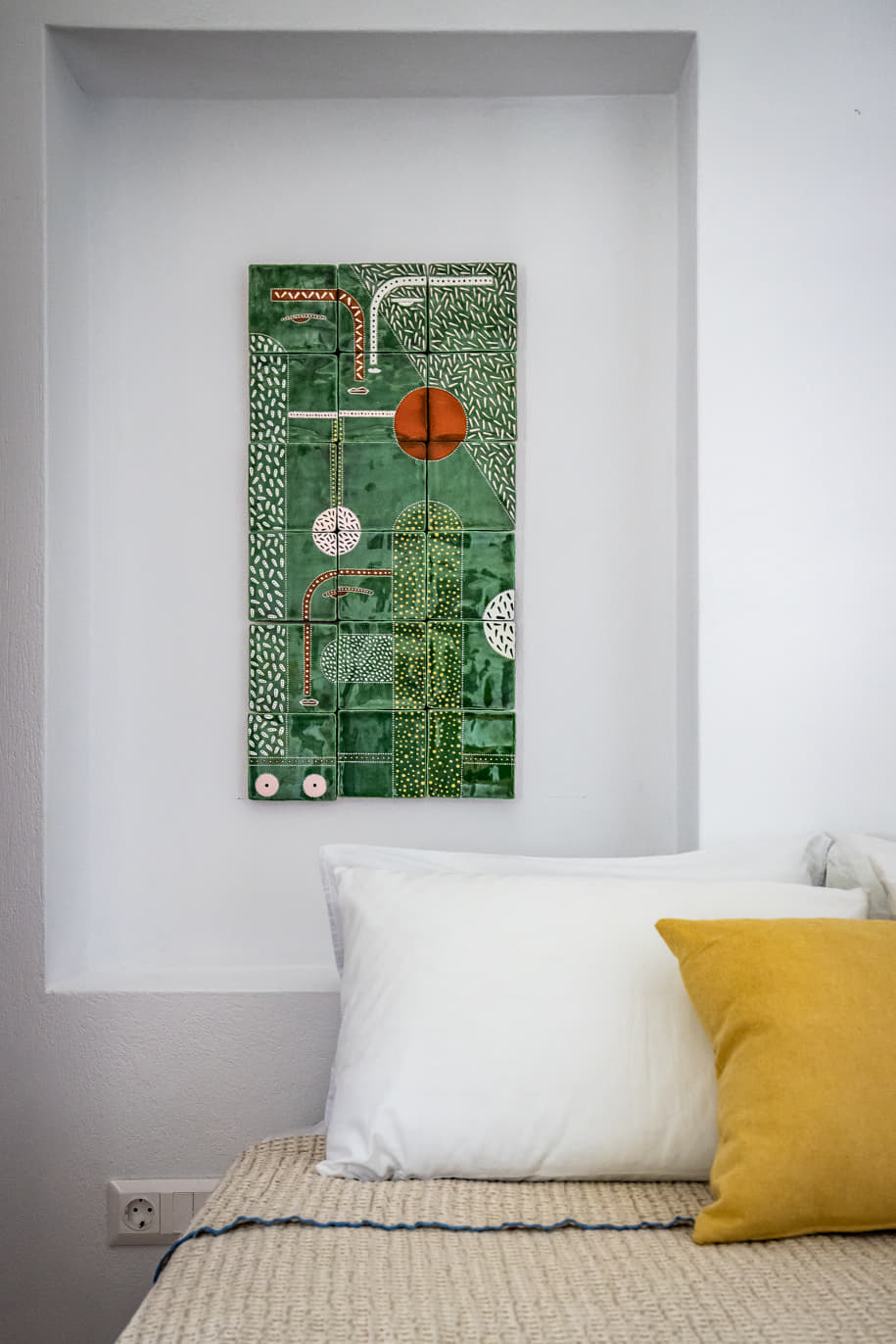
Με αυτόν τον τρόπο, η σύνθεση των δύο στοιχείων δεν είναι μόνο μια διαδικασία συγχώνευσης, αλλά και μια δημιουργική μετατροπή που δίνει ζωή σε νέες μορφές και ιδέες.
Η σύνθεση αυτή καθιστά το έργο μου ένα πεδίο όπου οι παλαιότερες και σύγχρονες επιρροές συνυπάρχουν αρμονικά, προσφέροντας μια αισθητική εμπειρία που συνδυάζει την πλούσια πολιτιστική κληρονομιά με τη σύγχρονη δημιουργικότητα.
Ποιος είναι ο ρόλος της συνεργασίας στη δουλειά σας; Συνεργάζεστε με άλλους καλλιτέχνες ή αρχιτέκτονες;
Η παραγωγή των έργων μου είναι κυρίως μια μοναχική και εσωστρεφής διαδικασία, την οποία απολαμβάνω πλήρως. Ωστόσο, τίποτα από αυτά δεν θα ήταν δυνατό χωρίς την πολύτιμη συνεργασία με καλλιτέχνες, αρχιτέκτονες, art curators και ανθρώπους που εκτιμούν το έργο μου και επιθυμούν να το ενσωματώσουν στον δικό τους χώρο.
Λόγω του ότι εργάζομαι κυρίως μέσω αναθέσεων έργων, έχω την τύχη να συνεργάζομαι με αρχιτέκτονες και σχεδιαστές σε ποικίλα έργα τόσο στην Ελλάδα όσο και στο εξωτερικό. Κάθε τέτοια συνεργασία είναι εξαιρετικά σημαντική για μένα και την προσεγγίζω ως μια μοναδική ευκαιρία να δημιουργήσω κάτι νέο και πρωτοποριακό.
Η συνεργασία με άλλους επαγγελματίες υποδηλώνει για μένα μια ευκαιρία να αναπτύξω νέες ιδέες και προοπτικές που ενδέχεται να μην είχα σκεφτεί μόνη μου.
Μέσα από την αλληλεπίδραση και την ανταλλαγή δημιουργικών προτάσεων, μπορώ να επεκτείνω το δημιουργικό μου ορίζοντα και να ενσωματώσω στοιχεία που ενισχύουν και εμπλουτίζουν το τελικό έργο.
Η συμμετοχή σε διαφορετικά έργα και η συνεργασία με επαγγελματίες από διάφορους τομείς συμβάλλει στη συνεχή εξέλιξή μου ως καλλιτέχνης, προσφέροντάς μου νέες προκλήσεις και πηγές έμπνευσης που είναι ανεκτίμητες για την ανάπτυξη και την ανανέωση της καλλιτεχνικής μου πρακτικής.
Πως φαντάζεστε να εξελίσσεται η δουλειά σας σε βάθος δεκαετίας;
Για τα επόμενα δέκα χρόνια, οραματίζομαι μια σημαντική εξέλιξη στη δουλειά μου, επικεντρωμένη σε δύο βασικούς τομείς. Ο πρώτος στόχος είναι η δημιουργία έργων μεγάλης κλίμακας που θα ενσωματωθούν σε κομβικά αρχιτεκτονικά έργα, τόσο ιδιωτικά όσο και δημόσια, στον Ελλαδικό χώρο.
Θέλω να συμβάλω στην αισθητική αναβάθμιση και την ενίσχυση της αρχιτεκτονικής και πολιτισμικής κληρονομιάς, δημιουργώντας έργα που θα αποτελούν σημείο αναφοράς για τον χώρο.
Ο δεύτερος τομέας στον οποίο επιθυμώ να εστιάσω είναι ο πειραματισμός με νέα υλικά και τεχνικές τόσο στον τομέα της κεραμικής όσο και στο design και την κατασκευή επίπλων.
Σκοπεύω να διερευνήσω και να ενσωματώσω νέες προσεγγίσεις, συνδυάζοντας την παραδοσιακή τέχνη της κεραμικής με σύγχρονες τεχνολογίες και σχεδιαστικές τάσεις.
Με αυτόν τον τρόπο, επιδιώκω να αναπτύξω νέες μορφές και λειτουργίες που θα ενισχύσουν τη λειτουργικότητα και την αισθητική των δημιουργιών μου.
Στοχεύω επίσης στη δημιουργία συνεργασιών με άλλους καλλιτέχνες και επαγγελματίες από διαφορετικούς τομείς, προκειμένου να εξερευνήσουμε από κοινού νέες ιδέες. Αυτή η διευρυμένη προσέγγιση θα μου επιτρέψει να ενσωματώσω ποικιλόμορφα στοιχεία και να επεκτείνω τα όρια της δημιουργικότητάς μου.
Εν κατακλείδι, φαντάζομαι τη δουλειά μου να εξελίσσεται σε μια συνεχή εξερεύνηση νέων τεχνικών και μεγάλων κλίμακας έργων, διατηρώντας παράλληλα τη σύνδεση με τις ρίζες της παραδοσιακής τέχνης, ώστε να δημιουργώ έργα που συνδυάζουν την ποιότητα, την καινοτομία και τη συναισθηματική αξία.
Myrsini Alexandridi, architect and artist, discusses with the Archisearch Editorial Team, about her professional career, the artistic and conceptual references of her work and the craftmanship. Following the thought of Greek artists and writers of the generation of the ’30s and drawing inspiration from elements of Greek tradition and history, the art of Myrsini Alexandridi seeks a “modern Greekness”.
How did architecture and drawing come into your life?
Architecture and drawing have always held a special place in my life, although their formal integration came later.
My journey began with my studies in architecture at the National Technical University of Athens (NTUA). Prior to enrolling in the program, my exposure to architecture was largely theoretical, shaped by my fascination with the intricate tapestry of urban environments and the serene, uncomplicated charm of smaller communities, such as Greek islands.
I perceived architecture as a profound force for shaping memories, fostering relationships, and creating enduring landmarks.
This initial perception, coupled with a lifelong passion for painting and drawing, naturally guided me towards a career in architecture. My early experiences with art and design fostered in me a deep appreciation for visual aesthetics and spatial relationships. As I immersed myself in architectural studies, I found that my artistic inclinations enriched my understanding of space and form.
Ultimately, my architectural journey seamlessly intertwined with my artistic pursuits, leading me to explore and integrate my creative expression into my work. The convergence of these two disciplines has allowed me to approach both architecture and art with a unique perspective, where each field enhances and informs the other.
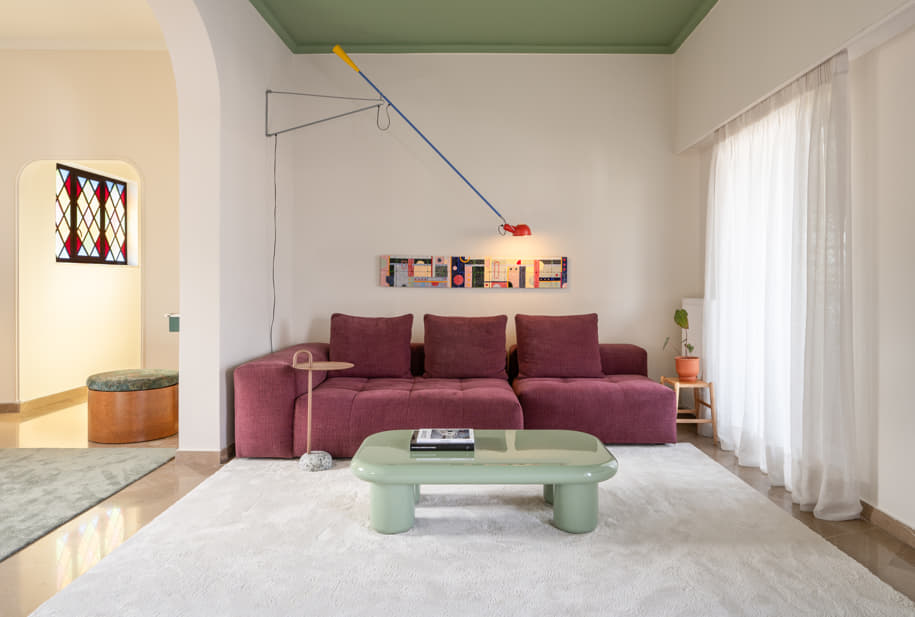
You are living and working in Stockholm. How did this movement come about and how has it affected your artistic and professional development?
I relocated to Stockholm about six years ago, shortly after completing my postgraduate studies at Berlage Institute in the Netherlands. The decision to move was influenced by friends who were already established in Stockholm’s architectural scene. They highlighted how well the Scandinavian working model aligned with my professional values and aspirations, which ultimately convinced me to make the move.
Since arriving in Stockholm, I have worked as an architect and, in early 2020, I launched my art business. Although I have transitioned to working exclusively in the art world, having stepped away from architectural practice, architecture continues to serve as a wellspring of inspiration for my creative endeavours.
The move to Stockholm has been profoundly transformative, both personally and professionally. The Scandinavian work environment, combined with the city’s friendly and welcoming atmosphere, has greatly contributed to my artistic growth. The distance from my place of origin has provided a fresh perspective and space for experimentation, which has been instrumental in shaping and advancing my artistic career.
Reflecting on these years, I have no regrets about my decision to move. The experience has enriched my professional journey and provided me with the opportunity to develop a unique artistic voice, informed by both my architectural background and the inspiring context of Stockholm.
What are the main influences and references in your work?
The primary influences and references in my work stem from the artists and writers of the 1930s generation. Figures such as Agenor Asteriadis, Yannis Moralis, Yannis Tsarouchis, and Nikos Engonopoulos have significantly shaped my aesthetic vision and creative approach. Their innovative themes and techniques, coupled with their skilful integration of Greek elements with the global trends of their time, serve as both inspiration and guidance in my artistic journey.
These artists of that era were pioneers in rediscovering and reinterpreting symbolism through a blend of Byzantine references, folk and classical art. They explored the Greek landscape, vividly portraying the Greek islands, and redefined the simplicity and purity inherent in ancient Greek art. Their work demonstrated a profound engagement with Greece’s rich cultural heritage, while also embracing modernity.
What inspires me most profoundly is their quest to find and maintain their own authenticity within this rich tradition, a pursuit they termed “modern Greekness.” This concept of melding deep-rooted Greek traditions with contemporary expression is central to my own artistic goals. I strive to build upon the enduring legacy of Greek art to create works that resonate with both historical depth and a modern sensibility, addressing today’s artistic concerns while honouring the continuity of our cultural heritage.
Υour work is both about art and architecture. How did you move from architecture to art and what is the role of handicraft in your work?
Art and architecture in my practice have a symbiotic relationship that complements rather than competes with each other. Throughout my career, I have aimed to enrich architecture with artistic elements and explore it through a more creative lens.
A contemporary architect whom I deeply admire for seamlessly blending architecture with art is Pezo von Ellrichshausen, whose work exemplifies this fusion.
For me, the transition from architecture to art has been facilitated through the materials I chose to engage with and explore.
The tile, an element that traditionally fragments a whole, serves as my bridge between art and architecture. While tiles are extensively used in architecture, I transform them through painting into distinct works of art.
This metamorphosis of tile from a mere construction material to a piece of artistic expression is made possible through craftsmanship. The tactile experience of working with materials, the texture of surfaces, and the hands-on approach to creation are integral to my concept of handicraft. Handmade techniques, involving direct interaction with materials and personal investment in the creative process, play a crucial role in my work, endowing it with a unique identity and authenticity.
By intertwining these elements, I create pieces that are not only visually compelling but also resonate with the depth and nuance of both artistic and architectural practices.
Tell us about your creative process. The canvas is fragmented and recomposed into a single whole. What do you perceive as a canvas?
My creative process begins with a crucial and foundational step: the pencil sketch on white paper. Confronting a blank surface can be both intimidating and challenging, so I mitigate this initial challenge by drawing a grid of squares with a ruler, where each square represents a tile.
This preparatory grid helps me to focus and channel my creativity into developing the initial concept.
Before starting the sketch, I conduct thorough research on the subject and mentally conceptualize what I want to depict. Once the preliminary sketch is complete, I analyse the composition to identify areas of detail and areas left open. The open spaces represent the tile surfaces left untouched, while the detailed parts, filled with colour or patterns, indicate where the colour will be applied.
After finalizing the sketch, I transfer it onto the tiles by redrawing the outlines in pencil. This step ensures that the design is accurately positioned on each tile, setting the stage for painting.
Next, I select a colour palette and meticulously paint the outlines and fill in the colours, adhering closely to the original sketch. This process involves a careful balance of precision and creativity to ensure that each tile contributes to the overall composition.
The final stage is the recomposition of the canvas. The fragmented nature of the initial design, where each tile acts as an individual piece, ultimately comes together to form a cohesive and harmonious whole. This method underscores the importance of both the individual tiles and their collective unity, reflecting how each component contributes to the overall artistic vision.
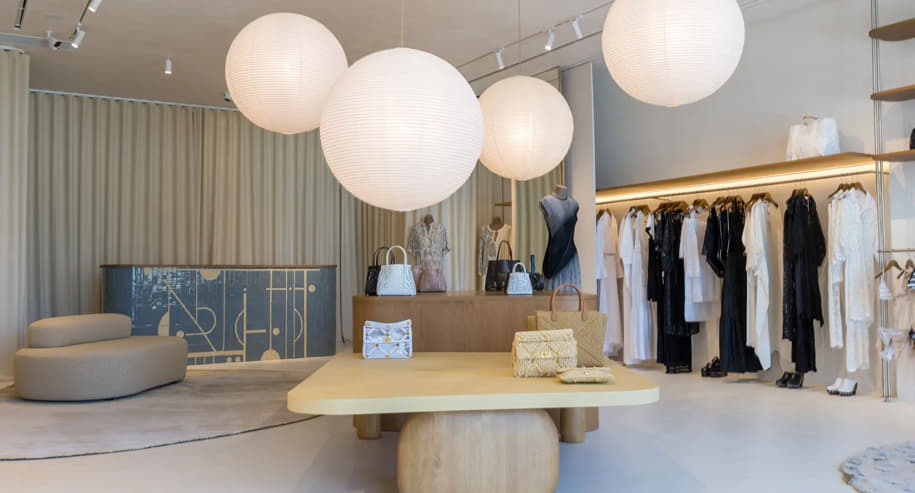
Your projects are compositions of individual tiles. Do you really perceive the ceramic tile as the initial unit of composition? Can this unit be transformed and if so how?
Yes, I view each tile as an independent unit that, when arranged collectively, forms the entirety of my work.
The fragmentation of the composition into individual tiles is essential for both the design process and the selection of colours. Each tile possesses its own autonomy, functioning as a discrete piece of art in terms of composition and colour.
Achieving harmony within each tile is crucial, as it translates into a cohesive and unified overall composition. I approach the design with the intention that each tile is a small, complete work of art in itself. When assembled, these tiles combine to create a larger, integrated piece that reflects a broader artistic vision.
The transformation of this unit can be achieved through various methods. Altering the shape and size of the tiles introduces a new dynamic to the composition.
I also explore different materials and textures, which add visual depth and complexity to the work. By experimenting with diverse materials, I enhance the tactile and aesthetic qualities of each tile.
Furthermore, the colour palette and patterns I employ significantly impact the perception of each tile. Through careful selection and application of colours and patterns, I create a diverse yet harmonious visual experience. This approach ensures that each tile plays a vital role in achieving both the aesthetic and conceptual unity of the overall piece.
What is the origin of the raw material you use for your work? Do you make the tiles yourself or do you source them from somewhere else?
My primary focus is painting on ceramic tiles, and given the intricate and time-consuming nature of tile production, I typically source them from specialized workshops.
I have established long-term collaborations with artisans in Portugal and Italy, who create handmade tiles of exceptional quality.
These partnerships allow me to concentrate on the artistic aspects of my work while ensuring that the tiles I use are both durable and aesthetically pleasing. The handmade tiles I receive are distinguished by their unique textures and character, which contribute additional depth and vibrancy to my paintings.
Do you perceive color as a primary compositional tool in your work, or does it follow the design and enhance it after the fact?
In my creative process, the drawing serves as the foundation for the composition. Although I start with a black-and-white approach, I already have a clear idea of the colour scheme and its interactions.
Colour is not just an afterthought but an essential dimension that integrates and enhances the design, reflecting the thought and intention behind it.
I follow informal, mental rules of colour harmony to guide my choices. Typically, I work with a palette of 3 to 4 colours: one or two primary colours that form the core of the composition, a secondary colour that adds depth and variety, and one or two accent colours that introduce elements of surprise and emphasis. This strategy maintains a strong visual coherence while allowing for creative expression and dynamic colour interactions.
Greekness, through mythological references, naturalistic depictions and architectural references, is unmistakably perceptible in your compositions. How is Mediterranean culture and the tradition that shapes it, reflected in your work and how does it manage to be combined with the Scandinavian abstract approach?
Greekness and Scandinavian abstraction serve as complementary forces in my work, enriching and expanding each other.
My compositions vividly capture Greek tradition through mythological references, architectural elements, and snapshots of folk culture. This rich heritage, with its vibrant colours and symbolic depth, provides a lush and expressive backdrop for my art.
Incorporating Mediterranean culture into my work involves celebrating its historical and cultural richness, while its inherent vibrancy adds layers of meaning and visual interest. The dynamic and multifaceted nature of Mediterranean tradition serves as a foundation for my artistic expression.
Conversely, Scandinavian design principles—characterized by clean lines and minimalist forms—offer a counterpoint to the Mediterranean’s complexity. This abstract approach introduces a refreshing simplicity that contrasts with and enhances the intensity of Mediterranean elements. By integrating Scandinavian minimalism, I infuse my work with a modern sensibility that highlights the timeless qualities of Greek tradition.
The synthesis of these two influences is not merely a fusion but a creative transformation. It breathes new life into traditional elements, blending past and present into a cohesive aesthetic.
This interplay between Mediterranean richness and Scandinavian clarity results in a harmonious and innovative artistic expression, where historical depth and contemporary creativity coexist seamlessly.
What is the role of collaboration in your work? Do you collaborate with other artists or architects?
While the creation of my works is primarily a solitary and introspective process that I deeply enjoy, collaboration plays an essential role in my artistic practice. My creative process would not be as rich or complete without the valuable input from artists, architects, art curators, and individuals who appreciate my work and wish to integrate it into their own spaces.
Given that I predominantly work on commissioned projects, I am fortunate to collaborate with architects and designers on a diverse range of projects, both in Greece and internationally.
Each collaboration is a significant and cherished opportunity for me to explore new ideas and innovate.
Collaborating with other professionals opens doors to fresh perspectives and novel concepts that I might not have considered on my own. The exchange of ideas and creative feedback helps me to broaden my artistic vision and incorporate elements that enhance and elevate the final outcome.
These interactions not only contribute to my growth as an artist but also provide invaluable challenges and sources of inspiration. Engaging with professionals from various fields enriches my creative practice, allowing me to continuously develop and refresh my artistic approach.
How do you imagine your work developing during the following ten years?
Over the next decade, I envision a profound evolution in my work, focusing on two primary areas of development. First, I aim to undertake large-scale projects that will be integrated into prominent architectural works, both private and public, in Greece.
My goal is to contribute significantly to the aesthetic enhancement and preservation of architectural and cultural heritage, creating artworks that serve as landmark references for their locations.
By infusing my work into these key architectural contexts, I hope to elevate and enrich the surrounding environment.
Second, I plan to delve into experimenting with new materials and techniques within ceramics, as well as in design and furniture making.
My intention is to merge traditional ceramic artistry with contemporary technologies and design trends, exploring innovative approaches that bring forth new forms and functions.
This experimentation will enable me to push the boundaries of both functionality and aesthetics in my creations.
Additionally, I aspire to collaborate with other artists and professionals across various fields. These collaborations will foster the exchange of diverse ideas, allowing me to incorporate a wide range of elements and perspectives into my work. By working together, we can challenge conventional boundaries and explore creative possibilities that might not be achievable alone.
In summary, I see my work evolving through an ongoing exploration of new techniques and large-scale projects while staying deeply connected to the roots of traditional art. My aim is to create pieces that blend quality, innovation, and emotional resonance, contributing to a richer and more dynamic artistic landscape.
READ ALSO: 'ΣΧΕΔΟΝ ΕΚΕΙ': ένα φωτογραφικό δοκίμιο από τον Γιάννη Πάλλη | Συνέντευξη στη Μελίνα Αρβανίτη-Πολλάτου
